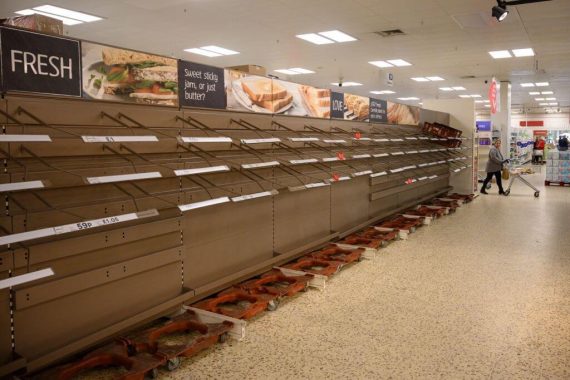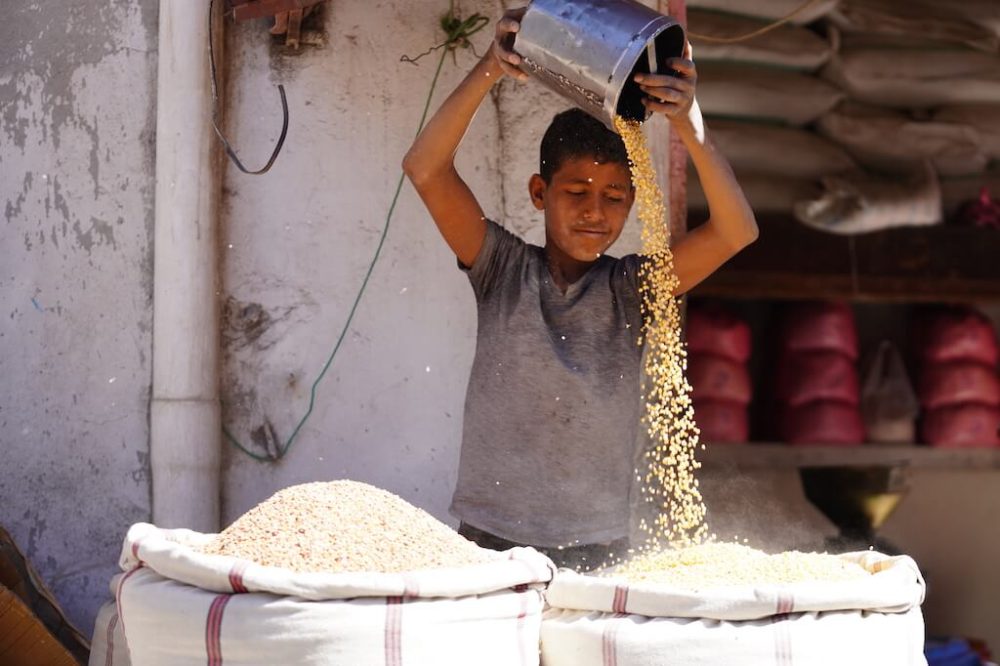The ongoing impact of the COVID19 pandemic and the long-term adverse effects of climate change have led to significant increases in food prices. Declining productivity in many parts of the world, rising global demand, and food supply chain problems have led to reduced stocks of grains and oilseeds. Prices reached the highest levels in the last decade.
Declining soybean yields in South America, reduced palm oil supply in Malaysia, and the use of palm and soybean oil for biodiesel production are driving vegetable oil prices to a record high. On the other hand, prices of energy-intensive basic inputs such as fuel, fertilizers, and pesticides continue to increase rapidly. Finally, the war in Ukraine is giving new impetus to food and input prices.
Russia’s ongoing war in Ukraine is threatening world agriculture and thus food security. Ukraine and Russia are agricultural powerhouses that make up a very important share of the world’s wheat, corn, oilseed, and fertilizer exports. The Ukraine war negatively affects all aspects of agriculture in the country and slows down exports from Russia.
Twenty-six countries across the world import at least half of their wheat from Russia and Ukraine. Low supply and high prices are likely to hit these most food-insecure countries first. On the other hand, the low supply and high prices of maize, oilseeds, and fertilizers play an increasing role in the prices of other commodities with their expansionist effects.
The Food and Agriculture Organization (FAO) announced that the global Food Price Index for March 2022 reached an all-time high with steady gains. In addition to the effects of climate change, the UN estimates that the number of people experiencing food insecurity worldwide could be at its highest level of the last 15 years due to the effects of the COVID19 pandemic and Russia’s invasion of Ukraine.
FAO’s moderate scenario shows that wheat prices may increase by about 9% in the short term, and over 21% in the severe scenario. Undernutrition scenarios show that the additional increase in the number of undernourished people in the world could reach more than 13 million in a few years. In short, war threatens the food security of millions of people.
Figures on agricultural trade
Over the past 30 years, the Black Sea region has become a major global supplier of grains and oilseeds, including vegetable oils. After the collapse of the Soviet Union, in the early 1990s, the region was a net importer of grain, while Russian and Ukrainian exports today account for about 12% of the total calories traded in the world. The two countries are among the top five global exporters of many important grains and oilseeds, mainly wheat with 34.1%, barley with 26.8%, sunflower with 23.9%, and corn with 17.4%.
Ukraine is also an important source of sunflower seed oil, providing about 49.6% of the global market. When we add Russia to this figure, this share rises to 72.7%. Many importing countries depend on these products from Ukraine and Russia. North Africa and the Middle East import more than 50% of their grains from these two countries, and most of their wheat and barley. Ukraine is an important supplier to many North African markets, including Egypt and Libya, as well as the EU and China.
On the other hand, Russia and Belarus, at the center of the war, are very important supplier countries in terms of agricultural inputs. Russia’s natural gas exports account for about 20% of global trade. Russia supplies about 40% of EU countries’ current imports. Natural gas is also an important raw material for the production of nitrogenous fertilizers such as ammonia and urea. The increase in fertilizer prices may accelerate as Russia is a major supplier of nitrogen fertilizers and potassium. Russia has a global export share of 15% in nitrogen fertilizer and 17% in potassium fertilizer.
Belarus, an ally of Russia and thus already the target of some international sanctions, accounts for an additional 16% of global potassium exports. Russia and Belarus supply 33.5% of nitrogen and 60.6% of potassium in fertilizer imports of European Union countries. Nitrogen and potassium originating from these two countries account for, on average, 64.7% of imports in Kazakhstan, 22.4% in China, 15.6% in India, 16.9% in the U.S., 32.6% in Brazil, 94.5% in the Central African Republic, and 65.1% in Nigeria. That is, for many countries, including Ukraine, dependence on Russia and Belarus is 60% or more for these imports.
By 2020/21, Turkey’s wheat export increased to 7.5 million tons and its imports to 9.8 million tons. Of this 9.8-million-ton import volume, 64.6%—or 6.4 million tons—is supplied from Russia, and 13.4%—or 1.3 million tons—from Ukraine. Although Turkey increased its sunflower oil production from 800,000 tons to 2,415,000 tons in 2021 doubling three times in the last 20 years, there is a deficit in oilseed production due to the much faster increase in consumption.
In order to fill this gap, Turkey imported 668,000 tons of sunflower and 820,000 tons of crude sunflower oil, 461,000 tons of which it exported after refining in 2021. Turkey imported 50.6% of its sunflower from Russia and 14.6% from Ukraine. Turkey imported 65.5% of its crude sunflower oil from Russia, and the rest mainly from Balkan countries and Ukraine. On the other hand, Turkey imports 5.7% of its total nitrogen fertilizer and 69.3% of its potassium fertilizers from Russia and Belarus.
Risks created by the Russia-Ukraine war
The war causes a decrease in the agricultural production of the region, problems in the food supply chain, and logistics disruptions, as well as risks that have already reflected on the whole world and negatively affect global food security. These risks can be examined both globally, in terms of Ukraine and Russia, and in terms of Turkey, which imports substantial amount of agricultural products and inputs from these two countries.
The most obvious risks are the trade-related ones. Due to the sudden and sharp decline in shipments between and by Russia and Ukraine, as already seen, countries importing wheat from Russia and Ukraine will definitely find alternative sources, pay higher prices or, worst of all, face shortages of supply. The war has already caused the closure of ports, oilseed processing plants, and other critical commercial facilities. In this sense, Turkey also experienced difficulties in the shipment of sunflower oil.
Price risk is also one of the leading risks. The global Food Price Index published by FAO averaged 159.3 points in March 2022, up 17.9 points (12.6 percent) from February, making a giant leap to a new highest level since its inception in 1990. The latest increase reflects new all-time highs for vegetable oils, cereals and meat sub-indices, while those of sugar and dairy products also rose significantly. The price increases in food supplies such as flour and sunflower oil in March added to the constantly increasing food prices and increased Turkey’s March food price index by 4.73 percent.
On the other hand, logistical risks also come to the fore. These include damages to roads, ports, storage, and processing facilities as well as port blockades. Ninety percent of exports from Ukraine take place through ports. In other words, there is a risk of loss of more than 15 million tons of different commodities that Ukrainian farmers cannot export. The capacity of the Western Ukraine border and the railway connection is around 300,000 tons per month. Ukraine, which usually exports around 4-5 million tons of goods in the spring, will not be able to do this. Therefore, Ukrainian trade logistics are at risk.
Meanwhile, production risk threatens the next production period. Considering the livelihoods of the Ukrainian farmers, their families, and those living in the countryside, the situation is alarming. What will be the output of the harvesting of crops currently planted? Will farmers be able to plant next spring? According to a field study, farmers in Ukraine have only 20% of the diesel fuel needed and 65% of the other inputs. Multinational companies that stop their operations for the safety of their employees, for example, cannot process sunflower into oil. Damages caused between the fields and the processing facilities, production logistics problems, and labor supply difficulties are important production risks.
The energy risk is one of the most common risks raised by those concerned. Agriculture is completely dependent on energy for, among others, the production of fuel, electricity, fertilizers, pesticides, and lubricants. These risks concern not only the war zone, but the whole world. Russia is a very important supplier of agricultural inputs, especially fertilizers and natural gas. This fact creates an additional layer of risk. Turkey, which imports a significant amount of these inputs from Russia, is also at significant risk.
Exchange rates, borrowing, and economic growth risks increase due to war. There is already a significant loss of value in currencies that will adversely affect investments. There are significant decreases in money conversion speed. Agriculture is the backbone of the economy in many developing countries of the world that borrow in U.S. dollars. The permanent appreciation of the dollar against the currencies of these countries due to the war causes very serious risks for these economies. The depreciation of the Turkish lira in the last three months gained a new momentum with the effect of the war and became a very serious source of risk.
Of course, the most important are human-centered risks. In this sense, besides the fact that Ukrainians are refugees in excess of three million, the risks to their lives and livelihoods come to the fore. Before the war, one in four Eastern Ukrainians was already receiving international support as they were food insecure.
We are entering a period in which the purchasing power of a whole nation will decrease with the decrease in agricultural production, decrease in economic activity, and increase in prices. It is clear that these developments will increase food insecurity and malnutrition in Ukraine.
Recommended
Conclusion
The parties to the war, Russia and Ukraine, have a very important place in the world in terms of the production and export of basic agricultural products such as wheat, sunflower, and corn. This means that in the case of prolongation of the war, countries that make a significant amount of their food supply from Russia and Ukraine, especially those whose food consumption is based on imports in the short term, may have to trade with new countries at higher prices. In this context, Turkey will have to find similar alternative sources of supply in the short term and to eliminate production deficits in the long term.
Along with Russia and Ukraine, Belarus has been drawn into the orbit of the war, which will affect not only the region but also the whole world in terms of energy in the form of natural gas, an important input for agriculture, and fertilizers containing nitrogen and potassium. This situation will cause serious risks by adversely affecting the agricultural markets in the medium and long term if the war continues. Turkey also faces similar risks in terms of the supply of these inputs.
Although it is not possible to eliminate completely all risks arising from the war as long as the war continues and even if it ends, they can be reduced. Efforts should be made to continue food and fertilizer trade as much as possible. Otherwise, the trade risks of war will require mitigation policies in third-party countries whose food supply is negatively affected, exacerbating world famine, and penalizing already food-insecure populations.
With the rapid increase in agricultural product prices, there is a risk that countries will isolate domestic producers by restricting exports. Such moves can have detrimental effects on importing countries, especially the most vulnerable, as experienced during the years of the world economic crises of 2007-2011. In this context, both international law enforcement sanctions and export restrictions used to protect domestic consumers need to be designed to protect global food security and their consequences for third parties need to be carefully evaluated.
The dependence of most of the world’s countries on energy products of Russian origin will bring new political debates to the agenda. Energy dominance and diversification strategies are likely to come to the fore. In addition, policies to increase biofuel production will be viewed with suspicion since re-orienting the consumption of agricultural products such as corn, wheat, and oilseeds to non-food uses all over the world is already creating significant tensions in the food and fertilizer markets. It is critical that a holisitc approach is taken to food and energy security making food and nutrition a priority.
It is everyone’s desire for the Russia-Ukraine war to end as soon as possible, for both humanitarian and economic reasons. However, similar crises have opened new exit doors in the past. With the increase in soybean prices, which is an important feed input, the export quota of the U.S. to Brazil in 1973 made Brazil one of the world’s important soybean producers. After the invasion of Afghanistan, in 1980, the export quota of the U.S. to Russia made the latter an important wheat producer. In other words, as the expression goes, “A bad neighbor makes one a property owner” has found its place. Like other countries that import from Russia and Ukraine, Turkey will have to open doors that are not overly dependent on foreign countries in terms of the products in question.






